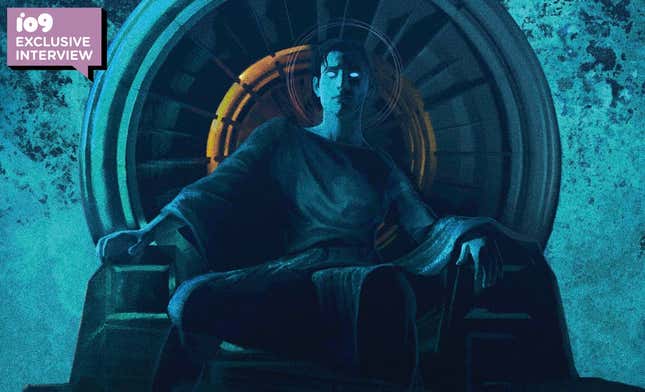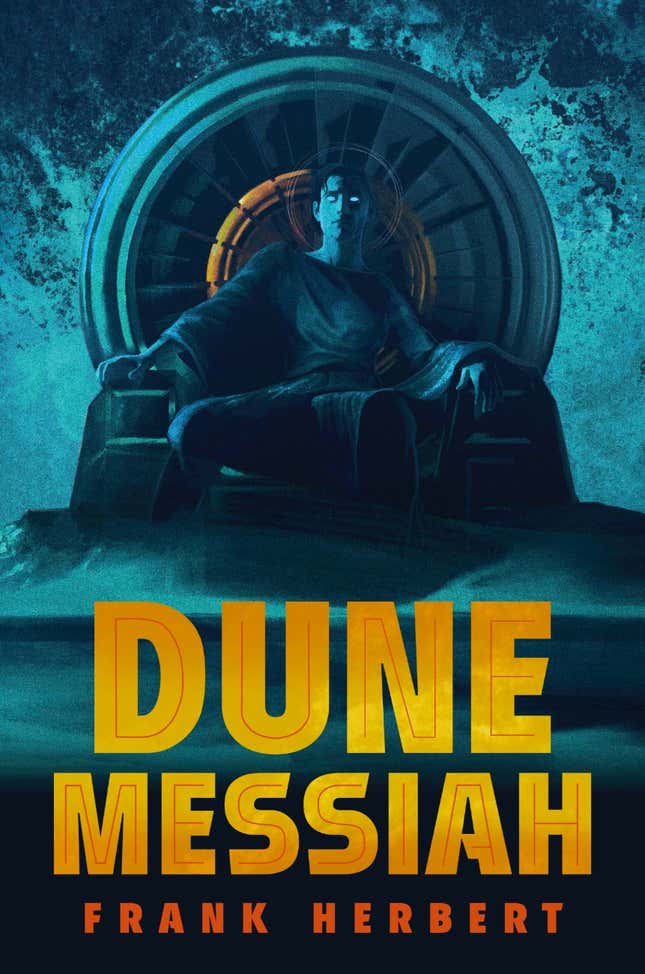
As the late 2023 release of Denis Villeneuve’s Dune: Part II draws closer, there’s no better time to further immerse yourself in the sci-fi realm created by Frank Herbert. Next year, Ace Books will be releasing more volumes in its deluxe hardcore treatment of the Dune series, and io9 has a first look, as well as an interview with artist Matt Griffin.
The books are the second and third in the series—Dune Messiah and Children of Dune—and according to the publisher, which already released a similarly souped-up edition of the first book, “both of these new deluxe editions will feature an iconic new cover, stained edges and fully illustrated end papers, a beautifully designed poster on the interior of the jacket, and an introduction by Brian Herbert.” Take a look at both of Griffin’s new covers, making their exclusive debuts here on io9!


“I was thrilled to have the opportunity to work with Matt Griffin again on Dune Messiah and Children of Dune,” art director Adam Auerbach said in a statement provided to io9. “His art for the first Dune deluxe edition struck the perfect balance between graphic power and detail. Matt carried this unique sensibility through the two deluxe sequels. In his work, he combines deep shadow with a vibrant sense of color. I think this combination is perfect for visualizing the mysterious yet vivid world of the Dune novels.”
Next up, our email interview with Griffin; it has been slightly edited for clarity.
Cheryl Eddy, io9: These aren’t your first Dune-related book covers. What’s your own relationship to Frank Herbert’s work? Are you a longtime fan of the series?
Matt Griffin: Actually they are my sixth and seventh! I’ve also done the covers for some of Brian Herbert and Kevin Anderson’s books (Sands of Dune, Duke of Caladan, Lady of Caladan, Heir of Caladan). I am a very long-time fan yes. My intro to Arrakis was actually the Lynch film—it was a family favorite when I was growing up, so I would have been pretty young when I first saw it. My Dad has always been into movies, so I was exposed to lots of great films as a small kid. It was watched regularly…
Then when I was about 14 I read the book, and it blew my mind. I decided there and then that a dream of mine would be to illustrate it someday, and decades later that dream came true. It had been a while since I read the sequels, so when I finished re-reading Messiah and Children for this job I continued, and am now enjoying God Emperor again. They are books you can return to over and over.
io9: With the Denis Villeneuve movies now sort of commanding the pop-culture idea of what Dune is (and what it looks like), is it more challenging as an artist to bring your own interpretation to the material? How did you decide on the specific imagery to use?
Griffin: No, I don’t think so. I really love what Denis Villenueve (and his production designer Patrice Vermette) dreamed up, but I wanted to keep this very much my vision of what that world is like. I guess it’s impossible not to have other interpretations floating in your head, whether from old masters like John Schoenherr or Bruce Pennington or contemporary Dune artists like Marc Simonetti. They are so inspiring. But I do my best to make this a direct link from book to image, via the filter of my own brain.
As for how I decide, it’s a slightly different process than normal, which is to highlight passages of text that might make for a good illustration. With these books, my intention is more to give glimpses of the world and try to achieve a sense of atmosphere more than anything else.
There’s also certain elements that you want to tackle, for example in the first book I just had to do Shai Hulud. And then also had this image of what a Sietch might be like, in caves that have been hollowed out by wind.
For the sequels, I wanted to do a Guild Navigator and felt the scenes of the conspiracy against Paul offered a perfect oppurtunity for that. The visit to the old Fedaykin Otheym offered a good opportunity to show a simple Arrakeen home, inspired by Middle-Eastern courtyards. On Children, I reverted back to desert scenes, showing the Laza Tigers and Leto II in his Sand Trout suit.
So I guess maybe I did lean a little more into scene-inspiration for these but, hopefully, with a lot of atmosphere. I want the viewer to feel like they’re there as much as possible, as I am when I’m reading the book and making the images.
io9: What inspires your use of color?
Griffin: Color is a very important part of my work, and I think the use of bold colors is probably a bit of a calling card now. But I don’t really plan ahead! It’s very much a process of playing around until it looks right to me. I mentioned the goal of atmosphere, and color plays maybe the biggest role in that. Texture, too. When I do the desert, for example, I want it to feel hot.
Every piece is a bit of a battle—a battle against being a bad image! So I wrestle with it, pushing and pulling and experimenting until I see something that makes me feel what I want others to feel.
io9: When you’re working on a project like this, how much creative freedom do you have? What’s the process of working with a publisher like?
Griffin: It always depends on the project, but in the case of these deluxe editions it’s a very freeing and trusting process. It’s an open brief, I’m allowed to come up with my own suggestions for images which are then sent over to the art director Adam Auerbach for feedback and then approval from the Herbert estate. I’ve worked with Adam for a good number of years now, and I think there’s a lot of mutual trust there, where I’m given the freedom to do my own thing (within reason!); I know he’ll steer me in the right direction if I need it.
There is of course some back and forth, but that generally always results in a better image. A good example is the worm from the first book. I had gotten that to a point where I felt it was finished, but Adam and Brian [Herbert] pushed me to work on it more. That pushing resulted in an infinitely better piece.
Sometimes publisher briefs can be very specific—which can also be a good thing. It can help to know exactly what they are looking for. But, I think, when it’s a property I’m clearly passionate about, I’m allowed do my thing. They know I’m doing it with love.
io9: What is the most enjoyable part about creating sci-fi and fantasy art, both for well-known books and your own original works?
Griffin: I’ve always loved both genres (and fusions of the two) because they stretch my imagination. I love reading it because it challenges me to imagine new things, or watching it because to me it’s an ulta-pure form of escapism. There are tropes in both, but really the scope is limitless. Within sci-fi and fantasy, absolutely anything is possible and I really love that.
For well-known books, I relish the oppurtunity to translate how I see that world. Great books make you forget you’re reading, and it becomes a movie in your head. Putting that down into a tangible image is challenging and rewarding in equal measure. As a story-teller [Griffin is the author of children’s book series The Ayla Trilogy] I like to give narrative to my personal work—I want them to hint at a much wider world and a much broader story. In fact, nearly all of my personal work for the last five years, since my last book came out in 2017, has been around one big story—all of it is connected. And so I am escaping into my own universe where anything can happen. A lot of it uses familiar elements—knights, samurai, motorcycles, etc.—but they are twists of those concepts, and are there as familiar touchstones, a kind of torchlight to guide you through the entrance. But the potential is there to explore new things and new ideas—break unfamiliar ground. And that is by far the most exciting thing on earth to me.
The deluxe hardcover releases for Frank Herbert’s Dune Messiah and Children of Dune will be out April 4, 2023. You can pre-order Dune Messiah here; Children of Dune here; and a deluxe hardcover box set of the first three Dune books here.
Want more io9 news? Check out when to expect the latest Marvel and Star Wars releases, what’s next for the DC Universe on film and TV, and everything you need to know about House of the Dragon and Lord of the Rings: The Rings of Power.